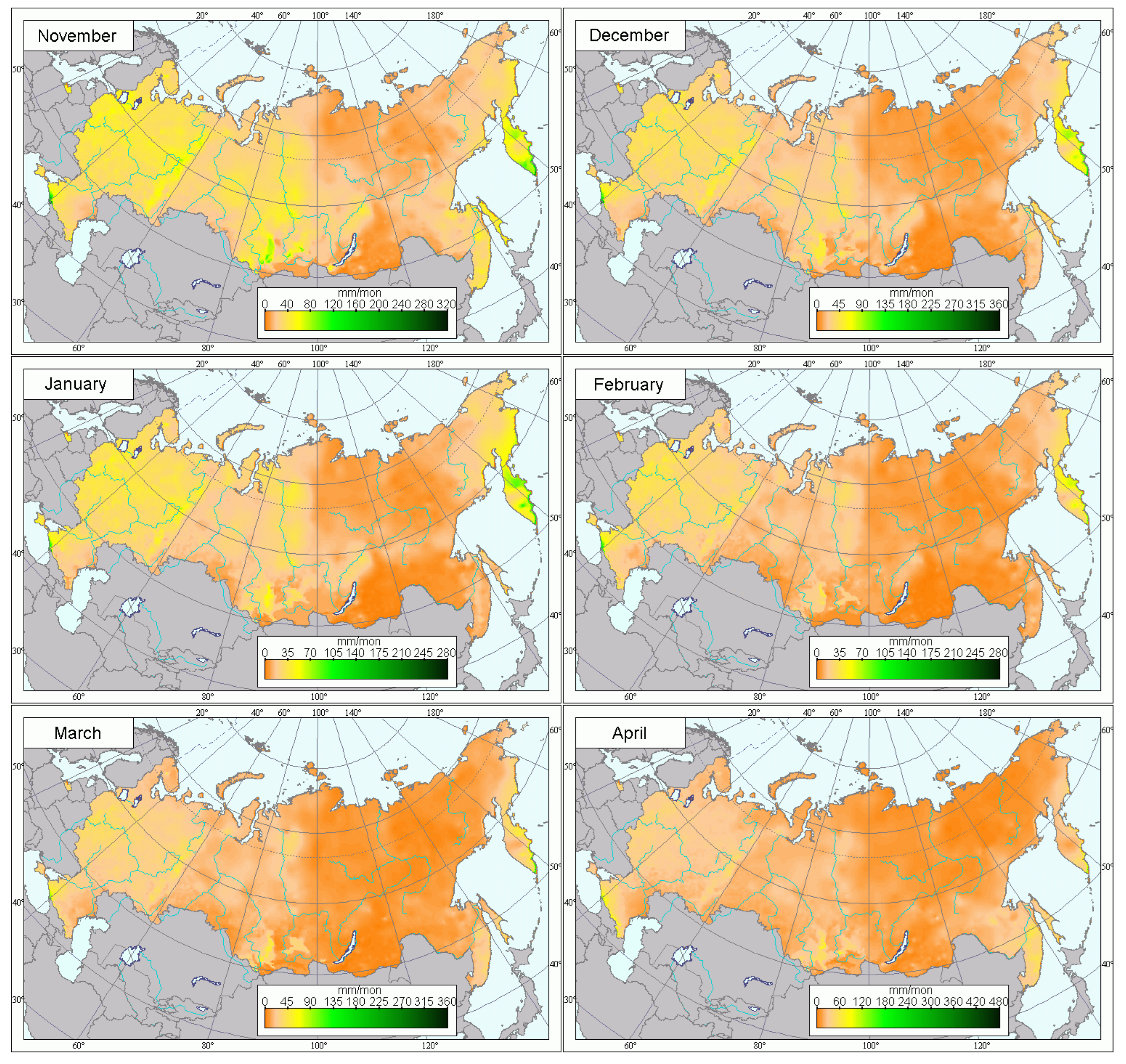Analysis of Roof Collapse Cases Caused by Snow Loads in Russia (2001–2021)
Abstract
:1. Introduction
2. Materials and Methods
3. Results
3.1. Analysis of the Number of Collapse Cases
3.2. Geography of the Collapses
3.3. Period of Roof Collapses
3.4. Characteristics of the Buildings
3.5. Damage and Victims
4. Description of the Main Disasters
5. Discussion
6. Conclusions
Funding
Institutional Review Board Statement
Informed Consent Statement
Conflicts of Interest
Appendix A
References
- Wardhana, K.; Hadipriono, F. Study of recent building failures in the United States. J. Perform. Const. Facil. 2003, 17, 151–158. [Google Scholar] [CrossRef] [Green Version]
- LENTA.RU: Funeral Dove-2006. Available online: https://lenta.ru/articles/2006/01/29/roof/ (accessed on 23 November 2021). (In Russian).
- Lobkina, V.A. Damage from snow loads in the Russian Federation. Causes and consequences. GeoRisk World 2012, 1, 50–53. (In Russian) [Google Scholar]
- Sadovský, Z.; Faško, P.; Mikulová, K.; Pecho, J. Exceptional snowfalls and the assessment of accidental snow loads for structural design. Cold Reg. Sci. Technol. 2012, 72, 17–22. [Google Scholar] [CrossRef]
- Piskoty, G.; Wullschleger, L.; Loser, R.; Herwig, A.; Tuchschmid, M.; Terrasi, G. Failure analysis of a collapsed flat gymnasium roof. Eng. Fail. Anal. 2013, 35, 104–113. [Google Scholar] [CrossRef]
- Bass, D.; O’Rourke, M. Observations of snow load on four school buildings in New England. In Proceedings of the SEI Structures Congress, Denver, CO, USA, 6–8 April 2017. [Google Scholar] [CrossRef]
- Le Roux, E.; Evin, G.; Eckert, N.; Blanchet, J.; Morin, S. Non-stationary extreme value analysis of ground snow loads in the French Alps: A comparison with building standards. Nat. Hazards Earth Syst. Sci. 2020, 20, 2961–2977. [Google Scholar] [CrossRef]
- Fırat Alemdar, Z.; Alemdar, F. Progressive collapse of a steel structure under expected snow loads. Eng. Fail. Anal. 2021, 125, 105378. [Google Scholar] [CrossRef]
- Vigneau, J.-P. 1986 dans les Pyrénées orientales: Deux perturbations méditerranéennes aux effets remarquables. Rev. Géogr. Pyrén. Sud-Ouest Sud-Ouest Eur. 1987, 58, 23–54. (In French) [Google Scholar] [CrossRef]
- O’Rourke, M.; Auren, M. Snow loads on gable roofs. J. Struct. Eng. 1997, 123, 1645–1651. [Google Scholar] [CrossRef]
- Bolduc, W.T. When the roof collapses. In Proceedings of the Structures Congress 2011, Las Vegas, NV, USA, 14–16 April 2011; Ames, D., Droessler, T.L., Hoit, M., Eds.; ASCE: Reston, VA, USA, 2011; pp. 1827–1838. [Google Scholar]
- Geis, J.M.; Strobel, K.M.; Liel, A.B. Snow induced building failures. J. Perform. Constr. Fac. 2012, 26, 377–388. [Google Scholar] [CrossRef]
- Kodeks. Available online: https://docs.cntd.ru/document/456044318 (accessed on 6 September 2021). (In Russian).
- Engedahl, E.R.; Villasenor, A. Global seismicity: 1900–1999. In International Handbook of Earthquake and Engineering Seismology, Part A; Lee, W.H.K., Kanamori, H., Jennings, P.C., Kisslinger, C., Eds.; Academic Press: London, UK, 2002; pp. 665–690. [Google Scholar]
- Podolskiy, E.A.; Izumi, K.; Suchkov, V.E.; Eckert, N. Physical and societal statistics for a century of snow avalanche hazards on Sakhalin and the Kuril Islands (1910–2010). J. Glaciol. 2014, 60, 409–430. [Google Scholar] [CrossRef] [Green Version]
- Afonin, A.N.; Lipiyaynen, K.L.; Tsepelev, V.Y. Mean precipitation values. In Interactive Agricultural Ecological Atlas of Russia and Neighboring Countries. Economic Plants and their Diseases, Pests and Weeds; Afonin, A.N., Greene, S.L., Dzyubenko, N.I., Frolov, A.N., Eds.; Available online: http://www.agroatlas.ru/en/content/Climatic_maps/Pcp/index.html (accessed on 25 November 2021).
- Meteorological Database Aisori. Available online: http://aisori-m.meteo.ru/waisori/index0.xhtml (accessed on 18 August 2021). (In Russian).
- Scientific and Applied Reference Book on the Climate of the USSR (Tatar ASSR, Ulyanovsk, Kuibyshev, Penza, Orenburg, Saratov Regions); Gidrometeoizdat: Leningrad, Russia, 1988; pp. 374–405. (In Russian)
- Scientific and Applied Reference Book on the Climate of the USSR (Sakhalin Region); Gidrometeoizdat: Leningrad, Russia, 1990; pp. 228–241. (In Russian)
- Wang, J.; Liu, H.; Chen, Z.; Ma, K. Probability-based modeling and wind tunnel test of snow distribution on a stepped flat roof. Cold Reg. Sci. Technol. 2019, 163, 98–107. [Google Scholar] [CrossRef]
- Potac, J.; O’Rourke, M.; Thiis, T.K. Determination of wall height to capture windward drift snow on flat roofs. Cold Reg. Sci. Technol. 2018, 150, 17–22. [Google Scholar] [CrossRef]
- O’Rourke, M.; Cocca, J. Improved Snow Drift Relations. J. Struct. Eng. 2019, 145, 04019027. [Google Scholar] [CrossRef]
- Gutenberg, B.; Richter, C.F. Frequency of Earthquakes in California. Bull. Seismol. Soc. Am. 1944, 34, 185–188. [Google Scholar] [CrossRef]
- Stepnov, A.; Chernykh, V.; Konovalov, A. The SeismoPerformer: A novel machine learning approach for general and efficient seismic phase recognition from local earthquakes in real time. Sensors 2021, 21, 6290. [Google Scholar] [CrossRef] [PubMed]
- Irwin, D.; Owens, I. A history of avalanche accidents in Aotearoa New Zealand. In Proceedings of the International Snow Science Workshop 2004, Wyoming, WY, USA, 19–25 September 2004; pp. 484–491. [Google Scholar]
- Winkler, K.; Schmudlach, G.; Degraeuwe, B.; Techel, F. On the correlation between the forecast avalanche danger and avalanche risk taken by backcountry skiers in Switzerland. Cold Reg. Sci. Technol. 2021, 188, 103299. [Google Scholar] [CrossRef]
- Nazarov, Y.P.; Zhuk, Y.N.; Simbirkin, V.N.; Egorov, M.I. Basmanny Market: Analysis of structural solutions and possible mechanisms of building fracture. Struct. Mechan. Anal. Const. 2007, 2, 49–55. (In Russian) [Google Scholar]
- Gallego, E.; Fuentes, J.; Ramirez-Gomez, A.; Ayuga, F. Effects of different snow load arrangements on steel silo roof structures. Adv. Struct. Eng. 2018, 21, 2507–2517. [Google Scholar] [CrossRef]
- Lobkina, V.A.; Kononov, I.А.; Potapov, А.А. Remote monitoring of the snow loads on a roof of buildings. Ice Snow 2016, 2, 246–252. [Google Scholar] [CrossRef]
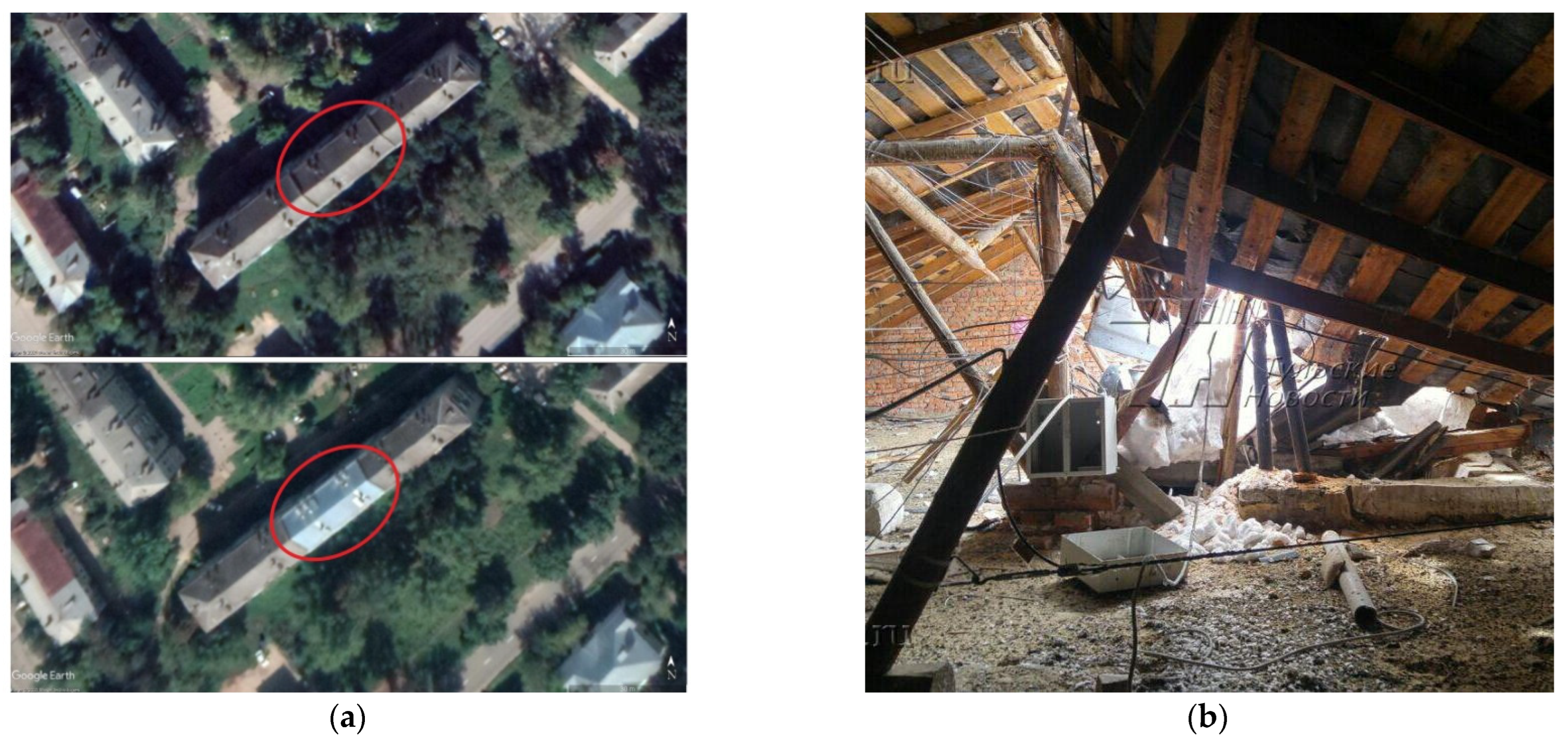
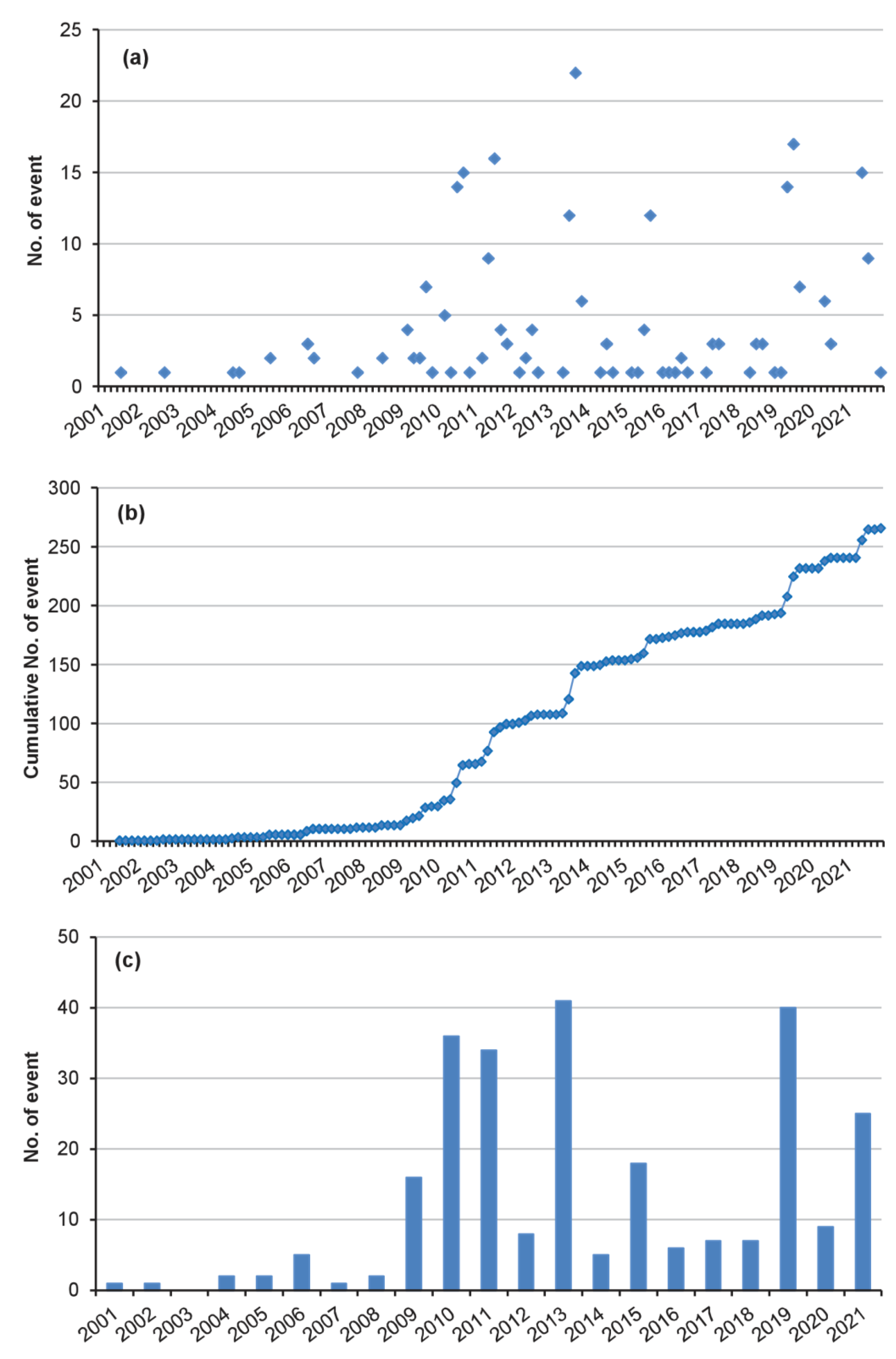




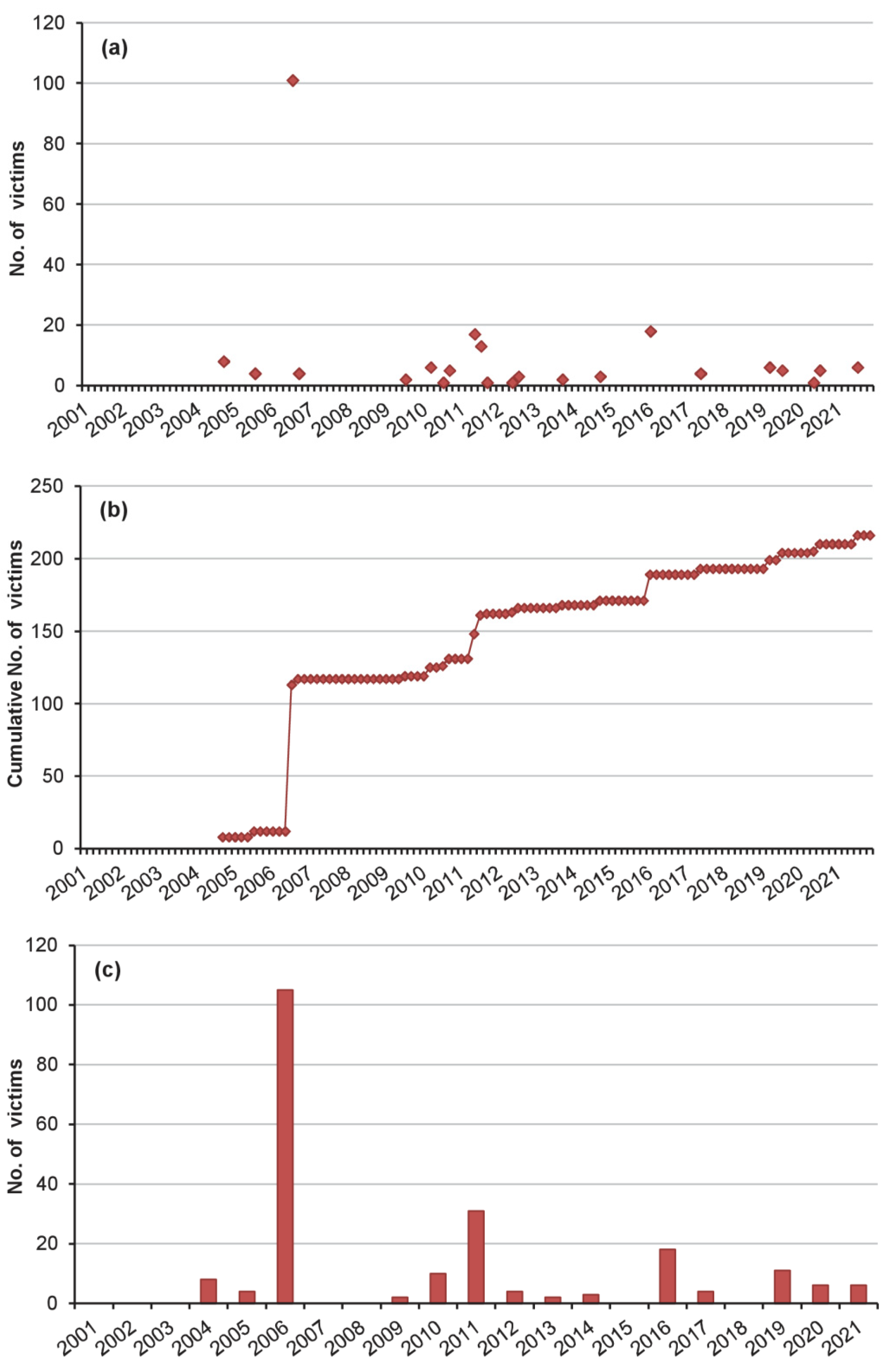
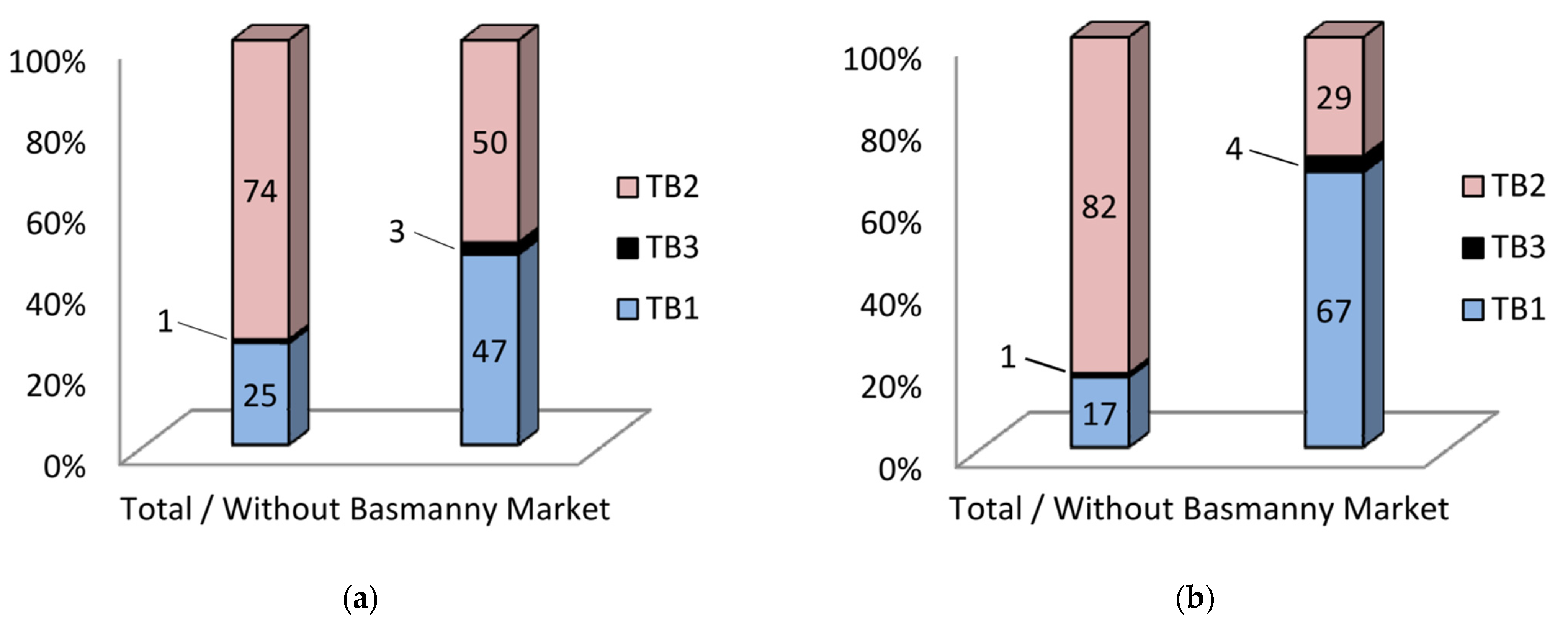

| Main Characteristics | Code | Scope of Work |
|---|---|---|
| Collapse Date (CD) | - | Collapse cases were divided by months to determine possible excessive snow load formation period |
| Collapse Location (CL) | - | The region of the settlement with collapse occurred was determined |
| Type of Building (TB) | TB1 | (1) Civil: |
| TB1.1 | Residential buildings | |
| TB1.2 | Public buildings—hospitals, schools, kindergartens, administrative buildings, etc., excluding sports buildings and shops | |
| TB1.3 | Sports buildings—stadiums, indoor skating rinks | |
| TB1.4 | Shops | |
| TB2 | (2) Industrial buildings—factories, factories and other industrial buildings, garage buildings, etc. | |
| TB3 | (3) Agricultural buildings—buildings for keeping livestock and poultry, repair and storage of agricultural machinery, storage of products, etc. | |
| Roof Shape (RS) | RS1 | Gable |
| RS2 | Arched/domed, including air-supported structures | |
| RS3 | Hipped | |
| RS4 | Flat | |
| RS5 | Single-slope | |
| RS6 | Stepped Flat Roof | |
| RS7 | Multigabled (cross-gabled) | |
| Roofing Materials (RM) | RM1 | Fiber cement |
| RM2 | Corrugated sheet | |
| RM3 | Vinyl roof membrane | |
| RM4 | Metal grooving | |
| RM5 | Glass | |
| RM6 | Heat fusing membrane roofing | |
| RM7 | Metal tile roofing | |
| Collapse Area (CA) | - | Divided into <50; 50–100; 100–300; 300–500; 500–1000; 1000–3000; >3000 m2 |
| Number of Floors (NF) | NF1 | Low-rise buildings—up to 2 floors |
| NF2 | Mid-rise buildings—from 3 to 5 floors |
| No. | Region | Number of Cases | No. | Region | Number of Cases |
|---|---|---|---|---|---|
| 1 | Saratov region | 24 | 10 | Altai territory | 8 |
| 2 | Moscow region and Moscow | 22 | 11 | Republic of Bashkortostan | 8 |
| 3 | Khabarovsk territory | 18 | 12 | Novgorod region | 8 |
| 4 | Sakhalin region | 15 | 13 | Kemerovo region | 7 |
| 5 | Novosibirsk region | 13 | 14 | Samara region | 6 |
| 6 | Leningrad region and Saint Petersburg | 12 | 15 | Sverdlovsk region | 6 |
| 7 | Primorye territory | 12 | 16 | Yaroslavl region | 6 |
| 8 | Kaluga region | 9 | 17 | Kaliningrad region | 5 |
| 9 | Republic of Tatarstan | 9 | 18 | Chelyabinsk region | 5 |
| Region | Number of Cases | ||||
| Bryansk, Ivanovsk, Tomsk regions, Krasnoyarskai territory, republic of Saha (Yakutiya) | 4 | ||||
| Volgogradsk, Voronezhsk, Ul’yanovsk regions, republic of Severnaya Osetiya-Alaniya | 3 | ||||
| Kirovsk, Kurgansk, Nizhegorodsk, Orenburgsk, Penzensk, Tambovsk, Tversk, Tul’sk regions, republics of Kareliya, Udmurtiya, Chuvashiya, Krasnodarskai territory | 2 | ||||
| Amursk, Arhangel’sk, Vladimirsk, Vologodsk, Irkutsk, Kostromsk, Kursk, Lipeck, Murmansk, Omsk, Orlovsk, Rostovsk regions, republics of Altai, Komi, Mari El, Mordoviya, Hantymansijsk AR | 1 | ||||
| Characteristic | TB1 | TB2 | TB3 | Percentage % | |||
|---|---|---|---|---|---|---|---|
| TB.1.1 | TB1.2 | TB1.2 | TB1.2 | ||||
| Roof Shape (RS) | |||||||
| RS1 | 26 | 5 | 2 | 2 | 2 | 13 | 19 |
| RS2 | 0 | 1 | 12 | 3 | 10 | 1 | 10 |
| RS3 | 22 | 3 | 1 | 0 | 0 | 0 | 10 |
| RS4 | 1 | 6 | 1 | 4 | 12 | 0 | 9 |
| RS5 | 0 | 6 | 0 | 1 | 1 | 0 | 3 |
| RS6 | 0 | 0 | 3 | 0 | 0 | 0 | 1 |
| RS7 | 1 | 0 | 1 | 0 | 0 | 0 | 1 |
| No Data | 46 | 46 | 5 | 10 | 15 | 4 | 47 |
| Roofing Materials (RM) | |||||||
| RM1 | 40 | 12 | 1 | 0 | 0 | 0 | 20 |
| RM2 | 1 | 6 | 4 | 6 | 16 | 14 | 17 |
| RM3 | 0 | 1 | 9 | 0 | 0 | 0 | 4 |
| RM4 | 0 | 4 | 0 | 1 | 3 | 0 | 3 |
| RM5 | 1 | 1 | 1 | 1 | 0 | 2 | 2 |
| RM6 | 0 | 2 | 0 | 0 | 2 | 0 | 2 |
| RM7 | 1 | 0 | 0 | 1 | 0 | 0 | 1 |
| No Data | 53 | 41 | 10 | 11 | 19 | 2 | 51 |
| Collapse Area (CA) | |||||||
| Less than 50 | 22 | 9 | 4 | 1 | 3 | 0 | 15 |
| 50–100 | 11 | 6 | 1 | 1 | 2 | 0 | 8 |
| 100–300 | 24 | 10 | 2 | 0 | 6 | 0 | 16 |
| 300–500 | 2 | 1 | 0 | 1 | 9 | 0 | 5 |
| 500–1000 | 1 | 0 | 1 | 1 | 6 | 0 | 3 |
| 1000–3000 | 0 | 1 | 3 | 0 | 5 | 10 | 7 |
| More 3000 | 0 | 0 | 0 | 1 | 0 | 2 | 1 |
| No Data | 36 | 40 | 14 | 15 | 9 | 6 | 45 |
| Number of Floors (NF) | |||||||
| NF1 | 41 | 28 | 12 | 6 | 21 | 15 | 46 |
| NF2 | 31 | 5 | 2 | 1 | 1 | 0 | 15 |
| No Data | 24 | 34 | 11 | 13 | 18 | 3 | 39 |
Publisher’s Note: MDPI stays neutral with regard to jurisdictional claims in published maps and institutional affiliations. |
© 2021 by the author. Licensee MDPI, Basel, Switzerland. This article is an open access article distributed under the terms and conditions of the Creative Commons Attribution (CC BY) license (https://creativecommons.org/licenses/by/4.0/).
Share and Cite
Lobkina, V. Analysis of Roof Collapse Cases Caused by Snow Loads in Russia (2001–2021). Sustainability 2021, 13, 13580. https://doi.org/10.3390/su132413580
Lobkina V. Analysis of Roof Collapse Cases Caused by Snow Loads in Russia (2001–2021). Sustainability. 2021; 13(24):13580. https://doi.org/10.3390/su132413580
Chicago/Turabian StyleLobkina, Valentina. 2021. "Analysis of Roof Collapse Cases Caused by Snow Loads in Russia (2001–2021)" Sustainability 13, no. 24: 13580. https://doi.org/10.3390/su132413580
APA StyleLobkina, V. (2021). Analysis of Roof Collapse Cases Caused by Snow Loads in Russia (2001–2021). Sustainability, 13(24), 13580. https://doi.org/10.3390/su132413580





